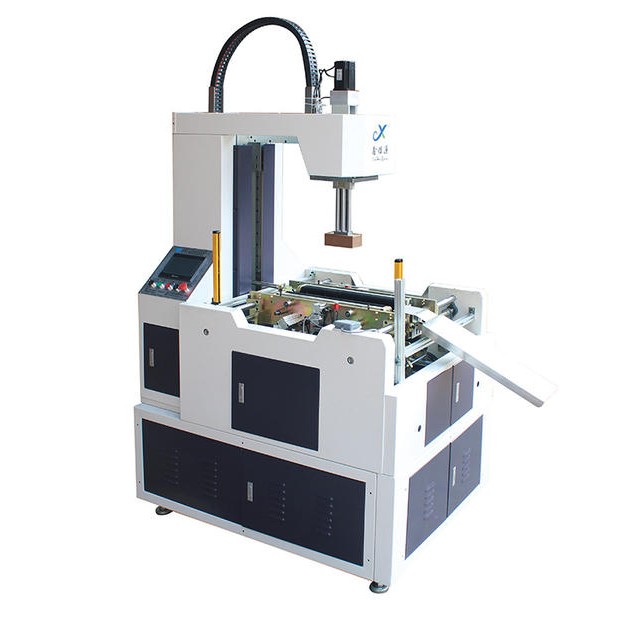In modern packaging, the choice of box material plays a pivotal role in packaging processes' efficiency, reliability, and longevity. When considering the acquisition of an automatic box-forming machine, it is essential to understand how the selection of box material can impact the performance of the device and the durability of the packages it produces.

The Significance of Box Material
Box material is more than just a physical container. It is the cornerstone of packaging that directly influences the structural integrity of the boxes produced. Whether investing in an automatic box-forming machine for high-speed production or a rigid box-forming machine for specialized applications, choosing box material is critical.
Choosing the suitable box material can optimize the performance of your machine, reduce downtime, and enhance the overall packaging process. This article will delve into the profound significance of box material and how it affects your automatic box-forming machine.
Let's start by examining some common box materials and their characteristics.
Common Box Materials
Regarding packaging, several materials are commonly used for making boxes. Each material has its own set of properties, advantages, and disadvantages. The choice of material depends on the specific requirements of your packaging process and the products being packaged. Here are a few common box materials:
Cardboard
Cardboard is one of the most widely used materials for boxes. It's affordable, lightweight, and eco-friendly. Cardboard boxes can be easily recycled and are suitable for various applications. However, they may not be as durable as other materials and are less fortunate for heavy or fragile products.
Corrugated Board
A corrugated board is a popular choice for shipping boxes. It consists of three layers: an inside, an outside, and a fluted layer. This design provides excellent strength and protection. Corrugated boxes are highly versatile and can withstand stacking and rough handling.
Plastic
Plastic boxes are durable, moisture-resistant, and suitable for specialized applications. They are commonly used for packaging food, electronics, and other products that require protection from moisture and contaminants. Plastic boxes are available in various forms, including polyethylene, polypropylene, and PVC.
The choice of box material depends on the intended use and the requirements of your packaging process. For example, if you need to package delicate electronic components, a rigid box-forming machine may be more suitable for creating robust plastic boxes. On the other hand, if you're dealing with shipping products that require extra protection, a corrugated board may be the ideal choice.
In the next section, we will explore how the selected box material can impact the performance of your automatic box-forming machine.
Performance Factors
The choice of box material directly influences the performance of your automatic box-forming machine. Here are some key factors to consider:
Speed and Efficiency
The box material's weight and thickness can affect the forming process's speed and efficiency. Lightweight materials like cardboard may allow for faster forming but may lack the durability for specific applications. Heavier fabrics like corrugated boards can provide better protection but may slow down the process slightly. It's crucial to strike the right balance between speed and box strength.
Forming and Sealing
Different box materials may require specific forming and sealing mechanisms. For instance, corrugated boards may necessitate various folding and sealing techniques compared to plastic. Ensuring that your automatic box-forming machine is compatible with the chosen material is essential for smooth operations.
Custom and Specialty Boxes
Sometimes, you may need custom or specialty boxes to meet unique product requirements. The chosen box material should align with the specifications of these custom boxes. Some automatic package-forming machines are designed to handle various box sizes and configurations, making them versatile for custom packaging needs.
The decision of box material should be a well-informed one, considering the needs of your production line and the capabilities of your automatic box-forming machine.
Longevity and Maintenance
The longevity of your automatic box-forming machine is closely linked to the choice of box material. Here's how it affects the lifespan and maintenance requirements of your equipment:
Durability of Boxes
The durability of boxes is a crucial factor. Different materials' packaging vary in resistance to external factors, such as moisture, temperature changes, and physical stress. For example, corrugated boxes are highly durable and can withstand rough handling during shipping, while plastic containers are moisture-resistant and ideal for food packaging. Choosing the suitable material ensures that the boxes maintain integrity throughout the supply chain.
Maintenance Requirements
Maintenance is integral to keeping your automatic box-forming machine in optimal condition. Different box materials can influence maintenance needs. For example, suppose your engine predominantly handles corrugated boxes. In that case, you may need to focus on maintaining the folding and sealing components due to the rugged nature of the corrugated board. On the other hand, if you use plastic boxes, your maintenance may revolve around different aspects, like cutting mechanisms.
Cost Implications
The choice of box material also has cost implications. While materials like cardboard are generally less expensive, they may lead to higher maintenance costs if unsuitable for the intended application. Understanding the long-term maintenance and box replacement costs is crucial for budget planning.
It's essential to balance the initial investment in box material with the expected maintenance costs to achieve the best results for your automatic box-forming machine.
In the upcoming section, we will explore case studies to showcase real-world examples of companies that have optimized their box material choices for improved performance and longevity.
Case Studies
Real-world examples can provide valuable insights into the impact of box material choice on the performance and longevity of automatic box-forming machines. Let's explore a few case studies that illustrate the positive outcomes of selecting the suitable box material:
Company A: Company A, a manufacturer of delicate electronic components, switched from cardboard to custom-made plastic boxes. This change not only improved the protection of their products but also reduced downtime related to box failures. Their automatic box-forming machine seamlessly adapted to the new box material, resulting in higher efficiency.
Company B: Company B, a large e-commerce retailer, experienced issues with packages getting damaged during transit due to using lightweight cardboard boxes. By transitioning to corrugated board boxes, they significantly reduced product damage and related customer complaints. Their automatic box-forming machines continued to operate smoothly with the new material.
These case studies emphasize the importance of aligning box material with product requirements and the capabilities of your packaging machinery. In both cases, the switch to a more suitable material improved machine performance and extended the longevity of the equipment.
Factors to Consider
When choosing the suitable box material for your automatic box-forming machine, several factors should be taken into account:
Product Characteristics
Consider the fragility, size, and weight of the products you are packaging. Fragile items may require sturdier box materials, while larger or heavier products may benefit from more robust packaging.
Environmental Concerns
Sustainability is a growing concern. Evaluate the environmental impact of your chosen box material. Cardboard and corrugated board are often more eco-friendly and recyclable than certain plastics.
Compatibility with Machinery
Ensure your automatic box-forming machine can handle the chosen material seamlessly. Compatibility issues can lead to malfunctions and production delays.
Cost and Budget
Balance the cost of the box material with the long-term maintenance and replacement costs. Consider the overall cost-effectiveness of your choice.
Special Requirements
If your products have unique requirements, such as temperature sensitivity or protection from moisture, factor in these special needs when selecting the box material.
Expert Recommendations
Selecting the suitable box material for your automatic box-forming machine is a decision that can significantly impact your packaging process's performance and the longevity of your equipment. To make an informed choice, consider the following expert recommendations:
Conduct a Material Analysis: Before deciding, perform a comprehensive analysis of your packaging needs, considering product characteristics, shipping conditions, and any special requirements.
Consult with Suppliers: Reach out to box material suppliers and packaging experts. They can provide valuable insights and suggest suitable materials for your unique needs.
Test and Experiment: If feasible, run tests with different box materials on your automatic box-forming machine to assess their compatibility and performance in a real-world setting.
Plan for Sustainability: In today's environmentally conscious market, consider the sustainability of your chosen box material. Eco-friendly options may align with your company's values and customer expectations.
Evaluate Long-Term Costs: Don't focus solely on the initial cost of the material. Consider the long-term maintenance, repair, and replacement costs associated with your choice.
Customization Options: Determine whether your machine can handle custom or specialty boxes, as this can provide flexibility and enhance your packaging capabilities.
By following these recommendations and understanding the critical role of box material in the performance and longevity of your automatic box-forming machine, you can make a well-informed decision that benefits both your operations and your bottom line.
Conclusion
In the complex world of modern packaging, the choice of box material is a decision that should be taken with seriousness. The material you select directly impacts the performance and longevity of your automatic box-forming machine. Whether you are considering cardboard, corrugated board, or plastic, each material has unique properties and benefits that can be harnessed to optimize your packaging process.
Remember that the correct box material can enhance your packaging operations' efficiency, reliability, and cost-effectiveness. By carefully evaluating your requirements, consulting experts, and conducting tests, you can ensure that your automatic box-forming machine operates at its best, producing high-quality packages that meet the demands of your industry.
In an era of rapid technological advancements and evolving customer preferences, the right choice of box material can make all the difference in your competitive edge. So, as you venture into the world of automatic box forming, remember the importance of this seemingly simple decision. It can be the key to unlocking the full potential of your packaging processes.
Thank you for reading, and we hope this article has provided valuable insights into the relationship between box material and the performance and longevity of automatic box-forming machines.
 English
English





